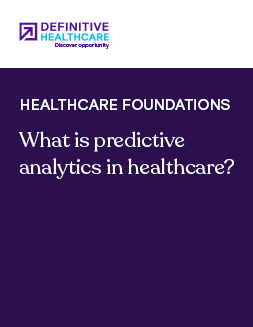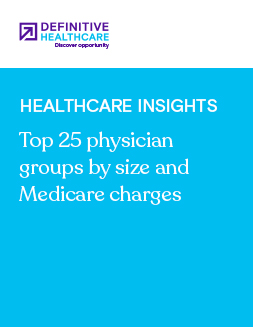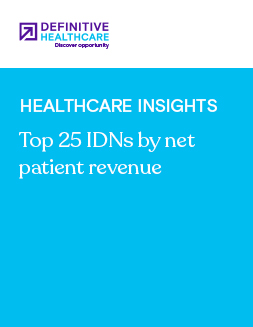Healthcare Insights
Top 25 largest academic medical centers
In the U.S., academic medical centers (AMCs) are hospitals that provide patient care while educating healthcare providers in partnership with at least one medical school accredited by the Liaison Committee on Medical Education (LCME) or the American Osteopathic Association (AOA). In many cases, providers continue their specialty education by participating in residencies at these facilities.
How many academic medical centers are there in the U.S.?
The Definitive Healthcare HospitalView product tracks nearly 220 active AMCs in the United States. Below, we have ranked the top academic medical centers by the number of interns and residents. Data on the number of interns and residents is from the Medicare Cost Report and is updated yearly.
| Rank | Definitive ID | Hospital name | City | State | Number of interns and residents | Explore dataset |
|---|---|---|---|---|---|---|
| 1 | 541974 | NewYork-Presbyterian Weill Cornell Medical Center | New York | NY | 1,977 | Explore |
| 2 | 2843 | Tisch Hospital | New York | NY | 1,336 | Explore |
| 3 | 2096 | University Hospital | Ann Arbor | MI | 1,023 | Explore |
| 4 | 731 | Yale New Haven Hospital | New Haven | CT | 959 | Explore |
| 5 | 1914 | The Johns Hopkins Hospital | Baltimore | MD | 941 | Explore |
| 6 | 3120 | Cleveland Clinic Main Campus | Cleveland | OH | 924 | Explore |
| 7 | 3571 | Hospital of the University of Pennsylvania | Philadelphia | PA | 867 | Explore |
| 8 | 3742 | Vanderbilt University Medical Center | Nashville | TN | 815 | Explore |
| 9 | 2442 | Barnes-Jewish Hospital | Saint Louis | MO | 810 | Explore |
| 10 | 395 | Ronald Reagan UCLA Medical Center | Los Angeles | CA | 804 | Explore |
| 11 | 3015 | UNC Medical Center (FKA University of North Carolina Hospitals - Memorial Hospital) | Chapel Hill | NC | 802 | Explore |
| 12 | 2973 | Duke University Hospital | Durham | NC | 789 | Explore |
| 13 | 2818 | Strong Memorial Hospital | Rochester | NY | 772 | Explore |
| 14 | 588 | Stanford Hospital - 300 Pasteur Dr | Palo Alto | CA | 759 | Explore |
| 15 | 1973 | Massachusetts General Hospital | Boston | MA | 745 | Explore |
| 16 | 3439 | UPMC Presbyterian | Pittsburgh | PA | 741 | Explore |
| 17 | 1135 | Northwestern Memorial Hospital | Chicago | IL | 724 | Explore |
| 18 | 3572 | Thomas Jefferson University Hospital | Philadelphia | PA | 719 | Explore |
| 19 | 756 | UF Health Shands Hospital (FKA Shands at the University of Florida) | Gainesville | FL | 716 | Explore |
| 20 | 1168 | Uchicago Medicine Mitchell Hospital - Hyde Park (AKA Bernard A Mitchell Hospital) | Chicago | IL | 716 | Explore |
| 21 | 1461 | University of Iowa Hospitals & Clinics | Iowa City | IA | 712 | Explore |
| 22 | 845 | Jackson Memorial Hospital | Miami | FL | 701 | Explore |
| 23 | 2976 | Atrium Health Wake Forest Baptist Medical Center (FKA Wake Forest Baptist Medical Center) | Winston Salem | NC | 686 | Explore |
| 24 | 3623 | Medical University of South Carolina Medical Center | Charleston | SC | 685 | Explore |
| 25 | 560 | UCSF Helen Diller Medical Center | San Francisco | CA | 670 | Explore |
Fig. 1 Data is from the Definitive Healthcare HospitalView product. Intern and resident data is sourced from the Medicare Cost Report and represents the most recent 12-month interval tracked in our database. Data accessed October 2025.
What is the largest academic medical center in the U.S.?
The largest academic medical center by number of interns and residents is New York-Presbyterian Weill Cornell Medical Center. This academic medical center is affiliated with Weill Cornell Medicine. With 1,977 interns and residents, New York-Presbyterian Weill Cornell Medical Center is also the top hospital by net patient revenue (NPR) in New York and the United States.
The second largest academic medical center is Tisch Hospital, with 1,336 interns and residents. Tisch Hospital is affiliated with the New York University School of Medicine. Like New York-Presbyterian Weill Cornell Medical Center, this academic medical center also tops the list of hospitals in New York and the U.S. with the highest net patient revenue, ranking second on both lists.
University Hospital comes third on the list with 1,023 interns and residents and is affiliated with the University of Michigan Medical School. It tops the list of hospitals in Michigan ranked by net patient revenue.
What is the difference between an academic medical center and a teaching hospital?
Academic medical centers and teaching hospitals are distinct medical facilities. Academic medical centers are affiliated with a medical school and confer medical degrees. Teaching hospitals may also be affiliated with a medical school but do not issue medical degrees. They typically include medical students, residents, and other healthcare professionals who are finishing or continuing their medical education.
The history of medical residency in America
According to the American Medical Association, the medical residency system was first introduced in the 19th century, as a way for healthcare providers to build skills toward mastery in their respective specialties. Though the healthcare landscape and care delivery systems have changed through the years, the basics of medical education have largely remained the same with a combination of classroom-based teaching and experiential learning through clinical service.
The role of academic medical centers in the staffing shortage
The United States has been experiencing a healthcare staffing shortage that has been exacerbated in recent years by providers retiring and others leaving the field due to burnout caused by excessive workloads during and following the COVID-19 pandemic.
One solution to aid in the shortages would involve more students enrolling and completing a medical degree to enter the field. While the number of matriculated and enrolled medical students increased from 2021 to 2022, the percent change year-to-year was lower than years prior. According to the Association of American Medical Colleges (AAMC), in 2021 there was a 1.5% increase in enrollment and a 1.9% increase in matriculants. While the total numbers continued to increase, in 2022 there was only a 1.2% increase in enrollment and a 0.2% increase in matriculants.
One way to keep the numbers trending in a positive direction is to make fundamental changes to how graduate medical education (GME) programs work. These programs are essential to the development of a physician’s knowledge and ability to provide care. GME training allows physicians to not only stay up to date on the latest medical developments but also contributes to physicians developing cutting-edge clinical research.
As it stands, GME programs are capped by Medicare. Expanding these caps could help to increase the number of students interested in pursuing careers in medicine.
Why target academic medical centers with your healthcare commercialization strategy?
Depending on your goals, academic medical centers can make valuable targets for engagement as part of a healthcare commercialization strategy.
Academic medical centers often staff a high concentration of specialists, some of whom may be key opinion leaders (KOLs) in the therapeutic areas your organization is targeting. With many of these specialists experienced in education and medical communication, they could make effective influencers and advocates for your product or service.
Additionally, academic medical centers tend to have large and complex patient populations, presenting potential opportunities for engagement, clinical trial recruitment, and more.
As hubs for research and innovation, academic medical centers are also likely to have expansive affiliations with other providers, researchers, and a variety of vendors.
Learn more
Healthcare Insights are developed with healthcare commercial intelligence from the Definitive Healthcare platform. Want even more insights? Start a free trial now and get access to the latest healthcare commercial intelligence on hospitals, physicians, and other healthcare providers.


